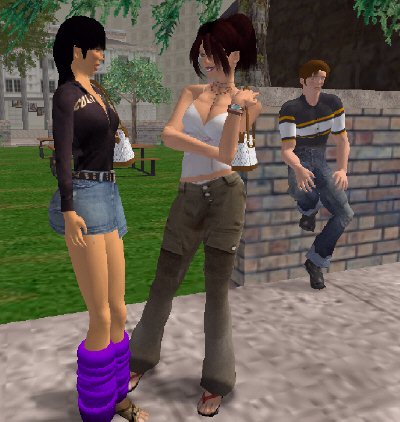|
|
|||||||||||||||||||||||||||||||
|
Second Life Review - Second Life not as hot as the hype
Second Life not as hot as the hype.June 12th 2007. Second Life provides an online society within a 3D world, where users can explore, build, socialize and participate in their own economy, essentially a 3 dimensional social networking site in which people create avatars (alter-egos) and explore/create the world of Second Life. Joining Second Life is free, but buying or selling goods and services and land requires an account. Business is conducted in Lindens, convertible at roughly 275 per US dollar, and can be transferered back and forth to real currency. With 3 million (2006 figure) registered users Second Life seems popular, but not all is as it seems. There is only approx. 100,000 active residents who are regularly on. The churn rate of the site is 85% (people who register, have a look and then never come back again). Second Life active users make up only approx. 3.4% of the registered users. [June 2007 updated figures: 7.1 million registered users, approx. 290,000 regular users.]
Second Life's popularity seems to be more closely linked with company's and governments that have fallen into the gimmick. Companies such as Advanced Micro Devices (AMD) search for game developers, 1-800-Flowers.com has setup a flower shop for delivering real and virtual flowers, Playboy sells merchandise/magazine subscriptions, Dell and IBM try to sell computers, but all of this seems for nought. Trying to do business in Second Life's virtual world is far more difficult and time consuming than doing business via a regular web site. To access Second Life, for example, you have download a viewer, set up an account, work out the controls, orientate yourself in the 3D world, and them clumsily try to locate and get to the company you're interested in finding out about. Its significantly easier to just google the company name and access its website. Thus having a Second Life presence is a gimmick more than anything else.
To cite Playboy as an example the Playboy virtual store features the same merchandise from its Internet sites, PlayboyStore.com and ShoptheBunny.com, and allows residents to purchase apparel for either their real life body and/or for their Second Life avatars. Politicians are also weighing in Second Life in an attempt to win votes. Japanese MP Kan Suzuki decided to set up an office in the virtual world from which he could discuss policies and give speeches to Second Life's politically minded Japanese users. Its a dubious move for the politician since Japanese users make up 9.2% of Second Life's registered users. The Swedish Institute set up an Embassy in Second Life in 2007. The Embassy serves merely to promote Sweden's image and culture on Second Life in an attempt to boost tourism and trade. As a concept Second Life is largely considered to be over-hyped. To get a better idea of how popular the game is lets compare its ranking on Alexa.com.
Alexa.com ranks websites based on popularity wherein #1 is the most popular [Yahoo.com is currently #1], and also measures Reach (how many other sites link to it) and Page Views (how many individual hits the site receives). Alexa also keeps track of where the users are coming from and the traffic rank of individual countries. Second Life's current ranking 1602, internet users spend approx. 0.055% of their time on SecondLife.com and users typically click on 4 pages per visit. 21.1% of users come from the United States, followed by 9.2% from Japan, 7.8% from Germany, 5.6% from the UK, 5.0% from Italy, 4.7% from France, 4.0% from Spain, 3.7% from Brazil, 2.7% from Portugal and 2.3% from Canada. Approximately 40% of all users are from Europe and 20% are from Asia.
So for viability purposes a Canadian company for example would be wasting time and effort setting up a shop on Second Life. Canadians prefer to spend their time on Facebook (#2 in Canada, #17 overall), YouTube (#6 in Canada, #4 overall), MySpace (#8 in Canada, #6 overall), or even NHL.com (#62 in Canada, its overall ranking fluctuates with the hockey season). A company operating in Europe or Japan however would have better chances of making a profit. For example the American Cancer Society tried to raise money on Second Life and only raised $40,000 US in 2006 despite months spent on the project. Part of Second Life's hype is the selling of virtual sex. Second Life permits sex, nudity, and profanity on private land in "mature" areas open to adults only. Linden investigates reports of abuse of this policy, as well as its rules against harassment, vandalism, and other antisocial behavior, and metes out warnings, suspensions or expulsions. Second Life has its share of cybersex-for-hire "prostitutes" and deviant sexual activity.
Another part of Second Life's hype is designers attempting to make money off of Second Life, but with one major flaw. With only 290,000 active users (many of which are trying to make a profit off each other) its a very competitive market. Second Life's biggest business is virtual fashion and accessories. Popular designers can make $50,000 to $70,000 US/year selling virtual "skins", but frequently find their designs being ripped off by other designers who merely change the colours or try to make improvements. Virtual weddings on Second Life is a smaller business, catering to the more romantically inclined. Advertisements on and off Second Life advertise weddings at virtual locales like the Heavenly Rose Wedding Gardens (buying a virtual wedding dress and tuxedo is extra). Indeed much of Second Life deals with commerce and trying to suck as much money out of the addicted users as possible. Some addicts spend 10 hours or more per day on Second Life, working part time jobs and living in a basement apartment to keep their Second Life personality "alive" while they attempt to make the amount of time they spend in the game profitable, but usually end up losing both time and money.
Some gamers take the games too seriously. Shanghai resident Zhu Caoyuan was stabbed for selling another gamer a sword from "Legend of Mir 3" that didn't belong to him for 7200 yuan ($1100 US). Others have managed to scratch out huge profits: Ailin Graef bought and sold cheap virtual land. She developed the land, redesigned it, cut it into subdivisions and sold the end results for millions. Ailin Graef is a property developer in real life. Some residents of Second Life are fearful of brand name companies coming in and putting "virtual grown" designers out of business. If a fashion companies like Gucci, the Gap and Banana Republic started opening virtual stores all over Second Life and offered both real clothes and virtual it would give clothing retailers an unfair marketing advantage that could put virtual designers out of work (many of which are barely scratching out a living). Second Life keeps detailed records of who is making money in their game. In May 2007 there was only 139 residents/companies that made more $5000 US during that month. That number is up from 90 during December 2006. So there is an increase in the number of people making a profit, but this is likely due to the number of people (approx. 3 million) who have signed up during the last 6 months (December 2006 to June 2007). The game doubled in popularity in the last year. Compared to other online games MMORPGs however Second Life is nothing. World of Warcraft makes up a whopping 52.9% of the market. Second Life is less than 1%. Conclusions? Second Life is over-hyped, not really that popular, sucks money out of its users and extremely few users actually make a profit. Thinking about trying to make money off Second Life? Don't bother. It sucks. I give it 2 stars out of 5.
|
|
||||||||||||||||||||||||||||||
|
Website Design + SEO by designSEO.ca ~ Owned + Edited by Suzanne MacNevin | |||||||||||||||||||||||||||||||






